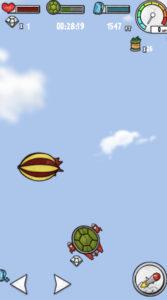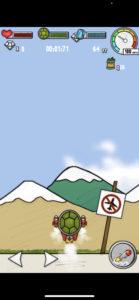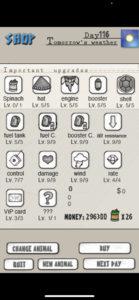



I played Turtle Fly on ios, a game by MJ Media. The premise of the game is that there is a doctor trying to see what modifications he can make so that a turtle can fly. It’s a single-player game with the goal of bypassing obstacles and seeing how far the turtle can go, given limited gas, health, and protections. Given the simple, straightforward, and yet miscellaneous theme and mechanics, I would say the game’s target audience is young children to teenagers, more specifically ages 8 – 17.
The type of fun it mainly depends on is that of a challenge as the obstacles are hard to overcome and one must take a lot of actions (sliding, jumping, moving) to get to the goal. There is also some fun derived from sensation as it’s a kinesthetic and sound-based experience, and from the narrative of the insane Turtle world.
Balance in Single-Player Games: The challenge level is appropriate to the audience as it is contingent on the rules of our world with a few twists. It’s clear that you need to bypass the obstacles and gain resources, but your ability to do so is limited by your current amount of resources, and by your skill level (which can increase depending on you). You can fly with the rocket fuel, and in order to be able to fly higher and higher into the sky, you need more power-ups and also practice. You also need to be able to avoid the obstacles, which as you reach higher altitudes, get more difficult and more dynamic. The rate at which you gain resources depends on your skill level, so either way, the game will be a challenge, but the more skill you have, the less time it takes to upgrade. So the pacing feels pretty on-point for players of different skill levels, which will happen naturally given the age range.
Balance in Asymmetric Games: Since the game is a single-player game, it’s not really asymmetric.
Balance of Different Strategies: There are a few strategies to invest your money; you can prioritize protection, fuel, or boosters. You can always choose whether you want to invest breadth-wise— focusing on leveling everything up at the same time— or depth-wise— really honing in on upgrading a particular aspect. In addition, there are achievements that can help you to keep engaged with the game as you continue to gather resources. Eventually, all stats will be maxed out, but the player can invest in things that complement their strengths (e.g. a player bad at avoiding obstacles could invest in more protection), making for more balance in terms of gameplay challenge.
Balance Between Game Objects: Transitive, Intransitive, and Fruity
There is definitely a transitive relationship between most resources as purchasing them requires money/tokens. Although there are some fruity transactions— the spinach cans can buy some interesting things— most of the game objects depend on “money” transactions which makes them easier to compare. Each upgrade also corresponds with a level so you can know, for example, if the defense is at the same level as your engine.
Moments of success often came from dodging ample obstacles narrowly. If I were to change something about the game, I would probably change the navigation. As it stands you have to navigate by pressing the buttons when you could just press any point of the screen rather than something at the bottom of the screen that affects the rest of the screen.
Nonetheless, given the goal and the fun, I would say it achieves its objectives. It’s a healthy type of challenge and passing by those obstacles and going higher in the sky— until you eventually reach space— feels good.


